Research Article - (2022) Volume 12, Issue 1
Contribution to the valorization of three breeding by products-preliminary estimates
S. Benouadah* and K. OulbachirAbstract
The by-products from breeding represent a source of important fertilization, However the fertilizing value of which remains still difficult to estimate exactly knowing that the organic matter liberates the mineral fertilizing elements slowly in time. Indeed, the nutrients contained in these products are present in different forms, mineral and organic, available for crops in very variable times. In this context, the present study aims to determine the fertilizing value of three types of manure, cattle, horses and poultry. The main analyzes carried out consisted of determination of total nitrogen, phosphorus and potassium. These elements give a precise idea of the composition of manure in nutrients. At the same time, we determined the organic matter which makes it possible to estimate the organic carbon content allowing the calculation of the C:N ratio. The latter will make it possible to assess the mineralization capacity of the nitrogen contained in organic products. The pH and the measurement of electrical conductivity were also determined. The results obtained showed that the poultry manure exhibited the highest significant contents of nitrogen and potassium (2.1%) and (2.2%) respectively. So, that he recorded an average phosphorus content with a content of (1.487%). In addition, the lowest significant C: N ratio (11.2) was recorded by this type of manure. It is therefore likely to offer the highest levels of nutrients during the growing season of plants so it should be used for crops with a short vegetative cycle, the other two for crops with a long cycle. Finally, we conclude that the levels of manure fertilizers vary from one manure to another and that manure amendments can contribute positively to the protection and enhancement of our edaphic resources.
Keywords
Manure, Cattle, Horse, Poultry, Fertilizing value, Algeria.
Introduction
According to the FAO estimate in 2009, the world's population will reach 9.1 billion by 2050. To prevent a food crisis and global famine and to be able to meet the food needs of all its inhabitants in 2050, FAO estimates that it is necessary to increase the world's agricultural production by 70%. This increase necessarily involves the intensification of crops. However, the latter increases the export of significant quantities of nutrients, and is considered one of the causes of soil depletion and declining crop yields (Cheverry, 1994). To address soil degradation in terms of nutrient deficiency for plants, farmers empirically use farm organic fertilizer inputs, which are complete fertilizers to compensate for soil degradation in terms of insufficient nutrients for plants, farmers empirically, resort to inputs of organic farm fertilizers, which are complete fertilizers (both organic fertilizer and soil conditioner). Which play an important role in improving and maintaining the quality and fertility of soils (Benouadah et al., 2020b; Karbout et al., 2021). These are substances which, when incorporated into the soil, improve its physical, chemical and biological properties (Soltner, 2003; Goldberger, 2008). Regular application of manure, and especially solid manure, improves moisture-holding capacity and nutrient recycling, and makes crops that are less vulnerable to extreme conditions such as excess water or drought (Benouadah et al., 2020a).
This work therefore deals with a subject whose importance is fundamental whether in the current global context, or even at the local level, because recent scientific work on Algerian soils is more or less rare, whether it is the inventory, mapping, valorization, defense and restoration, biology, or other aspect. This is why we are contributing through this study to better understand the fertility value of three by-products from livestock farming such as cattle, poultry and horse manures given the importance of livestock in these regions (cows: 2 million subjects, chickens: 240 million subjects and horses: 168 000 subjects) (M.A.D.R., 2017 and D.S.A., 2020). As animal manure contains organic matter, an improvement in soil properties is generally expected following its land application (Petrychenko et al., 2021), as reported in many individual studies (Emile and Denis, 2014; Koull and Halilat, 2016). Indeed, these systems work for sustainable management, given that they tend to reduce the use of chemical inputs, recover waste, help protect the soil resource and improve its organic status.
Materials and Methods
Different types of manure studied
For our experiment, we studied three types of manure (Fig. 1) in order to compare them. We call these manures "organic inputs" to distinguish them from "organic matter". Indeed, these inputs, although quite rich in organic carbon, sometimes include a large mineral fraction.

Fig 1. Different types of manure studied (Benouadah, 2019).
Poultry manure (PM)
It is a well-decomposed manure, consisting of a mixture of droppings and woodchip litter. He was brought back from the poultry farm in the Sébaine region (Tiaret, Algeria).
Horse manure (HM)
It is a fresh manure composed of a mixture of straw and droppings of horses of different breeds "Barbe, Arabe-Barbe, Purcent Arabe and Selle Français", from the big breeding horse center of the Wilaya of Tiaret.
Cattle manure (CM)
This is a well-rotted farmyard manure made up of a mixture of droppings and straw. It was taken from a pile of manure from a private cattle farm in the Sebaine region.
Manure sampling
According to Siboukeur (2013), the manure sample to be submitted to the laboratory must really represent the manure that will be spread on the plot. Proper sampling and analysis of manure in the laboratory provides information on actual nutrient concentrations, data that is necessary for planning for maximum crop yield and minimum impact on the environment.
In our case, separate samples were taken from various places and throughout the depth of three different manure heaps (05 samples for each type of manure), after removing the surface layers exposed to climatic hazards. Subsequently, the sub-samples were mixed well and stirred to form at the end representative composite samples for each type of manure (Samreen et al., 2017).
These samples were kept cool in a cooler and transported quickly to the laboratory, and immediately refrigerated pending analysis as storage of samples at room temperature can trigger mineralization and denature the sampled manure (Siboukeur, 2013).
Manure analyzes
A representative sample of each manure was taken and transferred to the Agro-Biotechnology and Nutrition in Semi-arid Zones laboratory of the University of Tiaret, Algeria and analyzed for:
Before air drying: The moisture analysis (H) of the manure samples was carried out on the same day as their collection; this is important information for knowing the water state of the different manure.
According to (Siboukeur, 2013), the manure moisture was calculated as:
H (%)=(W1-W2)/W2 × 100 ….(1)
Where W1 is the wet weight (g) and W2 is the dried sample.
After air drying: pH by pH-meter, electrical conductivity (EC) by the conductimeter (Mathieu et al., 2003), total organic matter (OM) by calcination (Moreno et al., 2001), nitrogen total (N) by the Kjeldhal method (Bremner et al., 1982), total potassium (P) and total phosphorus (K) by the atomic adsorption spectrophotometer (AAS) (Soltanpour et al., 1977).
Data analysis
One-way analysis of variance tests (ANOVA) were used to compare means and determine the significant differences (IBM Corp, 2013).
Results and Discussion
The fertilizing value of the manure studied was assessed by three types of characteristics:
• Physical and physic-chemical properties of different manures (mineral (MM) and dry (DM) matter, pH, EC…).
• Determination of the C:N ratio in order to know the rate of mineralization of organic matter from different types of manure.
• The composition of nutrients by the determination of the fraction directly usable by plants (nitrogen, phosphorus and potassium) of these manures.
The physical, physical-chemical characteristics of the different types of manure studied, namely pH, EC, H, MM and OM, are mentioned in Fig. 2-4.
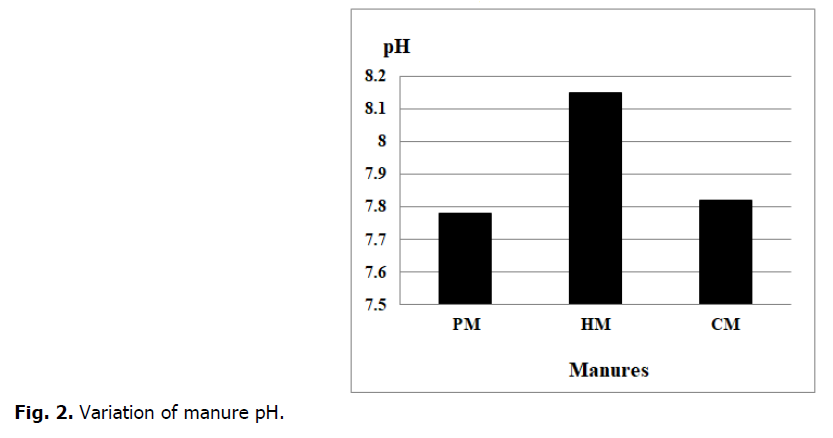
Fig 2. Variation of manure pH.
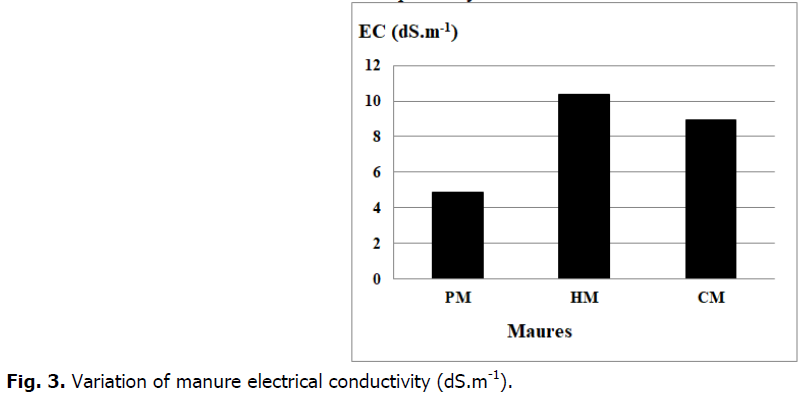
Fig 3. Variation of manure electrical conductivity (dS.m-1).
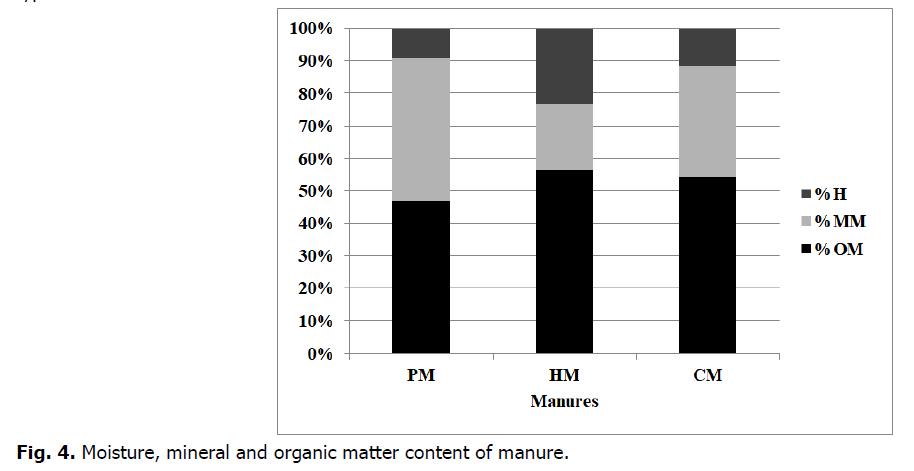
Fig 4. Moisture, mineral and organic matter content of manure.
pH variation depending on the type of manure
Poultry manure and cattle manure have slightly basic pH of 7.78-7.82 respectively while horse manure has a basic pH of 8.15 (Fig. 2). According to Siboukeur (2013), the pH value of organic waste is not stable. It depends on the composition of the inputs, the nitrogen content and the intensity of nitrification during storage.
Variation of EC as a function of type of manure
The classification of the three types of manure according to their electrical conductivity measured on extracts (1/5) followed in the following ascending order: poultry manure (4.87 dS.m-1)<cattle manure (EC: 8.93 dS.m-1)<horse manure (EC: 10.38 dS.m-1) (Fig. 3).
According to Chang et al. (1991), manure can have high levels of EC due to large amounts of mineral salts added to feed rations. Thus, excessive application of manure at high concentrations of salts, in the long term can lead to an accumulation of soluble salts in the soil. The low electrical conductivity recorded by poultry manure is probably due to its biochemical nature.
Variation of H, OM and MM contents depending on the type of manure
The comparison of the H, MO and MM contents according to the type of manure is shown in Fig. 4.
The relationship between these three parameters is expressed by the following formula:
100%=% H+% MM+% OM ….(2)
The results reported in Fig. 4 show that poultry manure and cattle manure are solid organic products and horse manure is pasty manure. The recorded moisture levels are 9.1%, 11.5% and 23.2% respectively for poultry manure, cattle manure and horse manure. The small difference in the moisture rate recorded between the two manures (PM and CM) can be explained by the fact that these products were dried before analysis or were dehydrated during storage and that HM is fresh manure. However, this difference may be important in the field. There can be important differences between fresh organic
produce and dried produce. In addition, manure storage can also play a role in determining moisture. Since the manure moisture decreases with the duration of storage (Siboukeur, 2013).
According to Znaidi (2002), it is necessary to take into account the dry matter (3) content and the visual appearance of the manure to choose a suitable spreading equipment.
DM=MO+MM ….(3)
In general, the higher the dry matter content, the more concentrated the product and therefore the richer in nutrients (Chabalier et al., 2006). These observations are in agreement with the results of our study, insofar as, we recorded a certain proportionality between the richness in minerals and the rate of dry matter. In fact, the contents of mineral matter vary between a minimum of 20.46% for horse manure and a maximum of 43.84% for poultry manure. While cattle manure records an intermediate value of 34%. The organic matter contents of the different manure samples analysed vary between a minimum value of 47.06% recorded by poultry manure and a maximum value of 56.34 recorded by horse manure. These significant variations in OM content can be explained on the one hand by the nature of the inputs, and on the other hand by the degree of mineralization of the manure at the time of analysis. In this case, poultry manure thanks to its high mineralization showed the lowest organic matter content (47.06%). However, the presence of a quantity of soil in the manure can also contribute to the decrease in the rate. However, the presence of a quantity of soil in the manure can also contribute to the decrease in the level of organic matter. On the other hand, the highest organic matter content recorded in the case of horse manure is certainly due to its richness in woody compounds compared to other types of manure.
Variation of C:N ratios depending on the type of manure
The C:N ratio is frequently used to assess the mineralization process of organic matter (Bernal et al., 1998). It can also be indirectly used to assess the stability of an organic product. In this regard, it is commonly accepted that the higher the C:N ratio of a product, the more it degrades slowly in the soil and provides stable humus (Siboukeur, 2013). The C: N ratio of the different manures is presented in Fig. 5. According to this Figure the C:N ratio of the different manures follows the following increasing order: Poultry manure (11.20).
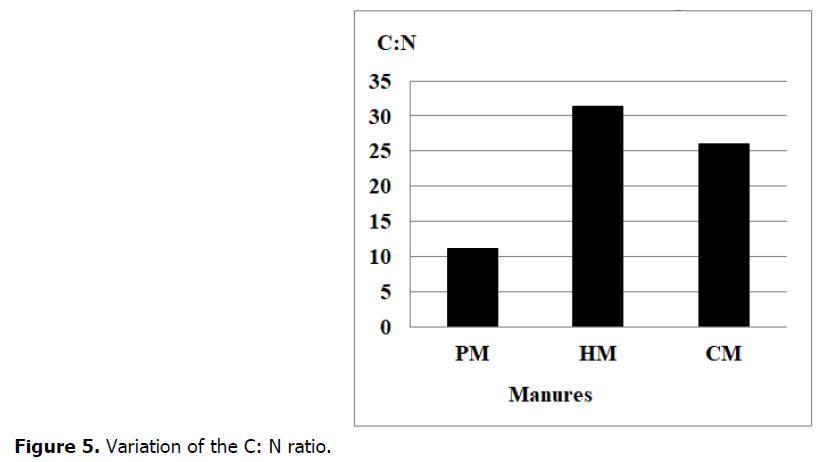
Fig 5. Variation of the C: N ratio.
The variation in the C:N ratio between the different manure is explained by the variability of inputs, by the intensity of the operations carried out in each rearing system, by their degree of mineralization and especially by the nitrogen content. Poultry manure is clearly distinguished from other types of manure by a much lower C:N ratio. Which, is related to its high nitrogen content. Thanks to its richness in nitrogen; this type of manure, once brought to the soil, it will be quickly mineralized by providing a lot of mineral nitrogen. However, the other two manure at higher C:N will conversely cause nitrogen immobilization by telluric microorganisms. The latter need nitrogen to develop their own protein molecules. The nitrogen thus reorganized is temporarily unavailable to the plant However, the other two manures with higher C: N will conversely cause nitrogen immobilization by soil-based microorganisms. The latter need nitrogen to make their own protein molecules. This reorganized nitrogen is temporarily unavailable to the plant (Siboukeur, 2013). This poses a risk of nitrogen hunger in the soil. In fact, real estate nitrogen is not immediately available to the plant. It is gradually released in small quantities by biological mineralization (Chabalier et al., 2006). These results agree with those of Znaidi (2002), who indicates that organic matter with a low C:N decomposes almost 50% faster than those deficient in nitrogen and with a high C:N ratio.
Fertilizer content depending on the type of manure Knowledge of the fertilizing value of an organic product is based on determining its composition (total nitrogen, phosphorus oxide (P2O5), potassium oxide (K2O) contents).
*To convert phosphorus and potassium to oxidized forms:
P × 2,291=P2O5 ….(4)
K × 1,205=K2O ….(5)
The comparative analysis of the fertilizer elements of the three manures, as well as the assessment of their fertilizer values are illustrated in Fig. 6.
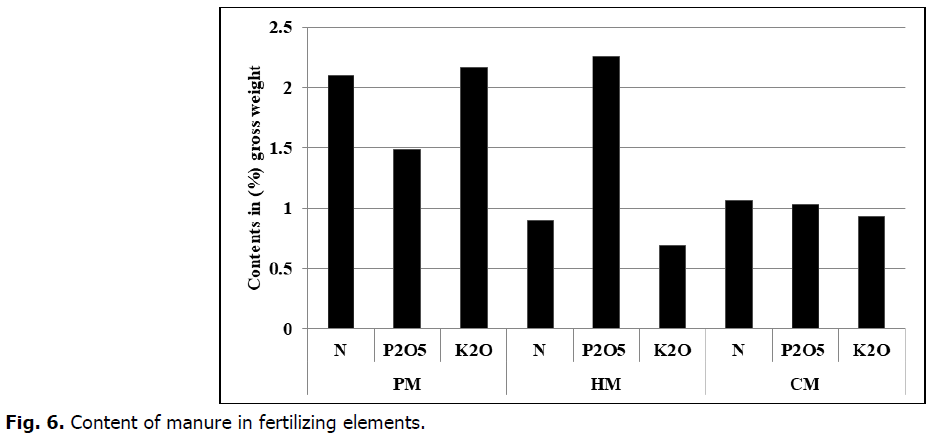
Fig 6. Content of manure in fertilizing elements.
Variation of total nitrogen content depending on the type of manure
Comparison between different manures for nitrogen content revealed that the highest significant (P<0.01) content was recorded by poultry manure with a content of 2.097%. Cattle manure was classified in second position with a content of 1.06%. Whereas, the lowest content of this element was recorded by horse manure with a content of 0.9%. These results confirm those of Adenawoola et al. (2005), who show that poultry manure is highly concentrated in nutrients, nitrogen, potassium and phosphorus. According to Figarol (2001), 70% of the nitrogen ingested by poultry is found in their droppings.
Variation of P2O5 content depending on the type of manure
From the results reported in Fig. 6, some superiority in P2O5 was noted in favor of horse manure. The other manures recorded lower levels of 1.5 and 1.03% respectively for poultry manure and cattle manure. According to Izigler and Heduit (1991), the fraction of the mineral phosphorus in farmyard manure varies depending on the animal species. It presents 80% of the total phosphorus for cattle manure and 60% for poultry manure.
Variation of the K2O content depending on the type of manure
Figure 6 shows that the highest K2O content was recorded significantly (P<0.01) by poultry manure with a content of 2.173%. The other manures recorded levels of 0.933 and 0.69% respectively for cattle manure and horse manure. Similar results were obtained by Adeyemo (2008), who reported the relative richness of poultry manure in potassium compared to other manures.
Conclusion
At the end of this study, which aims to assess the content of major plant nutrients, namely: the nitrogen, phosphorus and potassium content of three types of manure, namely: cattle, horses and poultry, we have arrived at the conclusions following: Poultry manure has the highest levels of nitrogen and potassium. Furthermore, its P2O5 content is average, which further enhances its fertilizing value for these three elements N2, P2O5 and K2O. Its C:N ratio is relatively lower, indicating that it will be subject to a rapid rate of mineralization compared to other manures. It therefore offers the maximum of nutrients to the plant during its growth phase. Whereas, the highest C:N ratios were recorded by cattle and horse manure. According to the C:N ratio it can be said that poultry manure can be used for crops with a short vegetative cycle, the other two for crops with a long cycle. From the above, we recommend the use of poultry manure for vegetable crops such as potatoes, tomatoes, etc., and that of the other two species for arboriculture. At the present time, not only compliance with legislation and environmental standards, but also and above all the very significant increase in the cost of mineral fertilizers make it necessary to consider the animal excrement stem from breeding animals as farm manure, real fertilizers, which for thousands of years have been the main source of fertilizers. Finally, manure amendments make a positive contribution to the protection and enhancement of our edaphic resources, because they provide a first solution to a current problem which is the loss of soil fertility (300,000 ha of agricultural soil at the local level) (FAO, 2015) and the decrease in their organic capital in semi-arid regions.
Acknowledgements
My sincere thanks and my deep appreciation for all those who contributed to the realization of this manuscript, especially Mrs Faraoun Fatiha et Ms Bouderballa Mohamed.
References
Adenawoola, A.R., Adejoro, S.A. (2005). Residual effects of poultry manure and NPK fertilizer residues on soil nutrient andperformance of jute (Corchorus olitoriusL). Nigerian Journal Soil Science, 15:133-135.
Adeyemo, C. (2008). Effect of poultry manure on soil physical and chemical properties, growth and grain yield of sorghum insouthwest Nigeria. American European Journal Sustain Agriculture, 2:72-77.
Benouadah, S., Oulbachir, K., Benaichata, L., Miara, M.D., Snorek, J. (2020a). Evolution of the microbial population of a cultivated soil with organic matter input under semi-arid conditions (Tiaret, Algeria). Ukrainian Journal of Ecology, 10:28-35.
Benouadah, S., Oulbachir, K., Benaichata, L., Miara, MD., Labdelli, F., Rezzoug, W. (2020b). Impact of organic amendments on soil physical properties under semi-arid climate (Tiaret, Algeria). Journal Fundamental Applied Sciences, 12:1386-1403.
Bernal, M.P., Sánchez-Monedero, M.A., Paredes, C., Roig, A. (1998). Carbon mineralization from organic wastes at different composting stages during their incubation with soil. Agriculture, Ecosystems and Environment, 69:175-189.
Chaballier, F.P., De Kherchove, V., Marcary, H.S. (2006). Guide de la fertilisation organique à la réunion.
Chang, C., Somemerfeld, T.G., Entz, T. (1991). Soil chemistry after eleven annual applications of cattle feedlot manure. Journal of Environmental Quality, 20:475-480.
Cheverry, C. (1994). Dégradation chimique des sols en Bretagne. Etude et Gestion des Sols, 1:7-21.
Emile, M., Denis, A. (2014). Animal manure application and soil organic carbon stocks: a meta-analysis. Global Change Biology, 20:666-679.
FAO. (2009). Comment nourrir le monde en 2050.
FAO. (2015). State of food and agriculture. Social protection and agriculture: Breaking the cycle of rural poverty. FAO, Rome, Italy.
Figarol, I.M. (2001). Bien valoriser les fumiers de volailles. La France Agricole No. 2916.
Goldberger, J.R. (2008). Diffusion and adoption of non-certified organic agriculture: a case study from semi-arid Makueni District, Kenya. Journal Sustain Agriculture, 32:597-609.
IBM Corporation Released. (2013). IBM SPSS Statistics for Windows, Version 22.0. Armonk, NY: IBM Corp.
Izegler, D., Heduit, M. (1991). Engrais de ferme: valeur fertilisante, gestion environnent, Rapport ITP, ITCF, ITEB, p:35.
Karbout, N., Mlih, M., Dhaouidi, L., Bol, R., Moussa, M., Nadhem, B., Bousnina, H. (2021). Farm manure and bentonite clay amendments enhance the date palm morphology and yield. Arabian Journal of Geosciences, 14:818-825.
Kebir, T. (2012). Etude de la contamination, de l'accumulation et de la mobilité de certains métaux lourds dans les sols potagers, fruitiers et agricoles situés à proximité d'une charge industrielle de l'usine alzinc de la ville de Ghazaouet. Thèse de Magister. Tlemcen: University, Abou Bakr Belkaid.
Koull, N., Halilat, M.T. (2016). Effects of organic matter on the physical and chemical properties of sandy soils in the Ouargla region, Algeria. Etude et Gestion des Sols, 23:923.
Mathieu, C., Pieltain, F., Jeanroy, E. (2003). Analyse chimique du sol: Méthodes choisies. Ed Tec and Doc, Paris, 18:40.
Oiu, L., Zhang, X., Cheng, J., Yin, X. (2010). Effects of black locust (Robinia pseudoacacia) on soil properties in the loessial gully region of the loess Plateau, China. Plant and Soil, 332:207-217.
Petrychenko, V.F., Lykhochvor, V.V., Olifir, Y.M. (2021). Application of green clover manure in winter wheat growing. Ukrainian Journal of Ecology, 11:91-93.
Samreen, S., Zahir, S., Wisal, M. (2017). Impact of organic amendments on soil carbon sequestration, water use efficiency and yield of irrigated wheat. BASE, 21:36-49.
Siboukeur, A. (2013). Assessment of the fertilizing value of different types of manure. Thèse de Master. Algérie: Université Kasdi Merbah, Ouargla, pp:15-45.
Soltner, D. (2003). Les bases de la production végétale. Tome I. Le sol et son amélioration. Collection Sciences et Techniques Agricoles, Paris, p:472.
Tahani, A. (2009). Look at experiences in Algeria and Egypt. Perspectives of agricultural policies in North Africa. Mediterranean Options, pp:144-172.
Znaidi, I.A. (2002). Etude et évaluation du compostage de différents types de matières organiques et des effets des jus de composts biologiques sur les maladies des plantes. Thèse de Master, Tunisie, p:58.
Author Info
S. Benouadah* and K. OulbachirCitation: Benouadah, S., Oulbachir, K. (2022). Contribution to the valorization of three breeding by products-preliminary estimates. Ukrainian Journal of Ecology. 12:25-30.
Received: 04-Jan-2022, Manuscript No. UJE-22-51202; Accepted: 25-Jan-2022, Pre QC No. P-51202; Editor assigned: 06-Jan-2022, Pre QC No. P-51202; Reviewed: 16-Jan-2022, QC No. Q-51202; Revised: 20-Jan-2022, Manuscript No. R-51202; Published: 03-Feb-2022, DOI: 10.15421/2022_331
Copyright: This is an open access article distributed under the terms of the Creative Commons Attribution License, which permits unrestricted use, distribution, and reproduction in any medium, provided the original work is properly cited.
